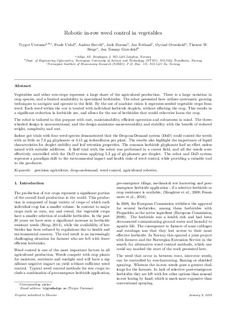| dc.contributor.author | Utstumo, Trygve | |
| dc.contributor.author | Urdal, Frode | |
| dc.contributor.author | Brevik, Anders | |
| dc.contributor.author | Dørum, Jarle | |
| dc.contributor.author | Netland, Jan | |
| dc.contributor.author | Overskeid, Øyvind | |
| dc.contributor.author | Berge, Therese W. | |
| dc.contributor.author | Gravdahl, Jan Tommy | |
| dc.date.accessioned | 2019-03-28T13:10:22Z | |
| dc.date.available | 2019-03-28T13:10:22Z | |
| dc.date.created | 2018-09-14T20:43:54Z | |
| dc.date.issued | 2018 | |
| dc.identifier.citation | Computers and Electronics in Agriculture. 2018, 154 36-45. | nb_NO |
| dc.identifier.issn | 0168-1699 | |
| dc.identifier.uri | http://hdl.handle.net/11250/2592250 | |
| dc.description.abstract | Vegetables and other row-crops represent a large share of the agricultural production. There is a large variation in crop species, and a limited availability in specialized herbicides. The robot presented here utilizes systematic growing techniques to navigate and operate in the field. By the use of machine vision it separates seeded vegetable crops from weed. Each weed within the row is treated with individual herbicide droplets, without affecting the crop. This results in a significant reduction in herbicide use, and allows for the use of herbicides that would otherwise harm the crop. The robot is tailored to this purpose with cost, maintainability, efficient operation and robustness in mind. The three-wheeled design is unconventional, and the design maintains maneuverability and stability with the benefit of reduced weight, complexity and cost. Indoor pot trials with four weed species demonstrated that the Drop-on-Demand system (DoD) could control the weeds with as little as 7.6 μg glyphosate or 0.15 μg iodosulfuron per plant. The results also highlight the importance of liquid characteristics for droplet stability and leaf retention properties. The common herbicide glyphosate had no effect unless mixed with suitable additives. A field trial with the robot was performed in a carrot field, and all the weeds were effectively controlled with the DoD system applying 5.3 μg of glyphosate per droplet. The robot and DoD system represent a paradigm shift to the environmental impact and health risks of weed control, while providing a valuable tool to the producers. | nb_NO |
| dc.language.iso | eng | nb_NO |
| dc.publisher | Elsevier | nb_NO |
| dc.rights | Attribution-NonCommercial-NoDerivatives 4.0 Internasjonal | * |
| dc.rights.uri | http://creativecommons.org/licenses/by-nc-nd/4.0/deed.no | * |
| dc.title | Robotic in-row weed control in vegetables | nb_NO |
| dc.type | Journal article | nb_NO |
| dc.type | Peer reviewed | nb_NO |
| dc.description.version | acceptedVersion | nb_NO |
| dc.source.pagenumber | 36-45 | nb_NO |
| dc.source.volume | 154 | nb_NO |
| dc.source.journal | Computers and Electronics in Agriculture | nb_NO |
| dc.identifier.doi | 10.1016/j.compag.2018.08.043 | |
| dc.identifier.cristin | 1609730 | |
| dc.relation.project | Norges forskningsråd: 234226 | nb_NO |
| dc.description.localcode | © 2018. This is the authors’ accepted and refereed manuscript to the article. Locked until 7.9.2020 due to copyright restrictions. This manuscript version is made available under the CC-BY-NC-ND 4.0 license http://creativecommons.org/licenses/by-nc-nd/4.0/ | nb_NO |
| cristin.unitcode | 194,63,25,0 | |
| cristin.unitname | Institutt for teknisk kybernetikk | |
| cristin.ispublished | true | |
| cristin.fulltext | postprint | |
| cristin.qualitycode | 2 | |

